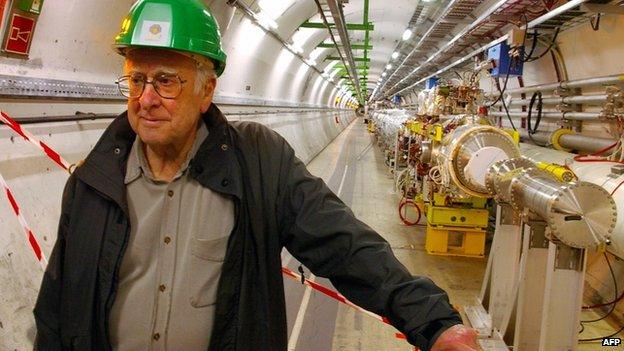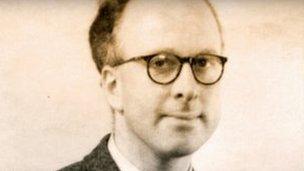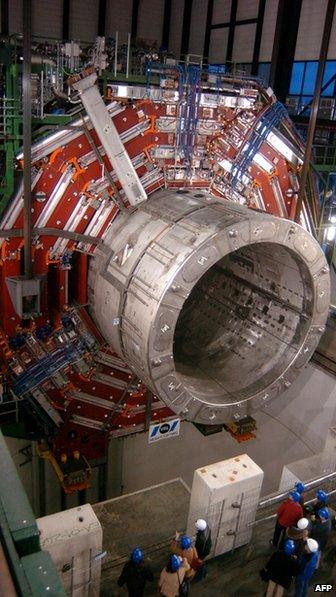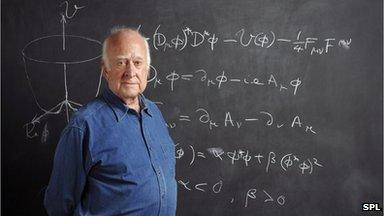Peter Higgs: Behind the scenes at the Universe
- Published

Professor Peter Higgs inside the Large Hadron Collider, the most powerful "atom smasher" ever built
Here's something to inspire every late developer: Peter Higgs didn't win a prize for physics until he was 52.
Mind you, by then he'd come up with an idea that changed the Universe - or at least how we look at it.
He set out to explain not just why we are here, but why everything is here.
The dominant theory is that it all began about 14 billion years ago with the Big Bang. Almost immediately some of the energy released began to condense into fundamental particles.
The process of creating the stuff around us - matter - was under way.
The process of creating that matter depended on some fundamental particles acquiring mass. But how? Good question: if everything started with a vacuum how could things that had mass come out of nothing?
It's one of the most important questions in science.
Without mass, the Universe would still be a cloud of fast-moving particles. Without those particles clumping together, no protons, no neutrons; no atoms, no molecules; no stars or galaxies or planets. No us.
It was Peter Higgs's achievement to come up with a mathematical solution in Edinburgh in the early 1960s.

By his own admission, Peter Higgs was not a distinguished experimental physicist
He had no PC - they hadn't been invented yet. Not even a pocket calculator. Just a fountain pen, some scrap paper and a mind that could look back billions of years.
Born to an English father and Scottish mother, Peter Higgs showed early promise as an above average scholar. At school in Bristol he failed to win prizes only in history and physics.
His interest in physics grew as he delved deeper into chemistry, and in particular the nature of matter. His thoughts went deep inside molecules and atoms to the fundamental particles themselves.
It had to be theoretical physics for a very practical reason: he was a pretty hopeless experimenter.
"It wasn't clear what sort of skills I had in other kinds of activity in physics," he says.
"In fact I was already I think, at the age of 18, showing signs of being incompetent in the lab."
It can help to think of scientists as model makers. They observe what's going on and build a theoretical model they think explains what they see.
Then they test it. Sometimes the model is wrong and falls apart. Sometimes it just needs a few tweaks before it stands up. And sometimes they find there's a bit missing.
When it came to the fundamental building blocks of matter, some scientists built what they prosaically dubbed the Standard Model.

It took nearly half a century to prove Professor Higgs' theory
It says there are quarks - particles that combine to make up protons and neutrons. And there are leptons like the electron.
Quarks and electrons hang together to make up the matter we see around us. What makes them hang together are other, even more exotic particles called Bosons.
Different types of Bosons carry different forces: the strong nuclear force binds quarks together into those protons and neutrons. The weak nuclear force helps the sun shine, among other things. And the electromagnetic force makes atoms hang together to make the world around us.
But every time they built the Standard Model, they found there was a missing piece: how did the particles that had mass, get that mass? Many people tried to explain it, some got close. But Peter Higgs came up with the most elegant theory.
His theory called for a field stretching across the Universe in every direction. Some particles pass through it unaffected.
But other kinds of particles get bogged down in it. The more they get bogged down in the Higgs Field, the more mass they have. And if you could create ripples in the field, at a certain point you'd see another kind of Boson. The Higgs Boson.
Proving the theory correct would take an enormous international effort - and almost half a century.
It involved creating the biggest and most sophisticated machine humankind has ever built, at the CERN nuclear research centre on the outskirts of Geneva.
The Large Hadron Collider (LHC) lies in a circular tunnel almost 17 miles round. It's so big it's partly in Switzerland, partly in France. It took 10 years and thousands of scientists and engineers to build it.
It puts a beam of protons into the emptiest vacuum in the solar system. It's colder than the depths of space. It accelerates those protons to 99.999999% the speed of light - then does the same to an identical beam travelling in the opposite direction. Each of the trillions of protons goes round the circle more than 11,000 times a second.
Enormous detectors dotted around the ring are waiting, as is the world's biggest supercomputing grid.

Higgs enthusiasts camped overnight in order to get a seat in Cern's lecture theatre
Because when they smash the two beams together, it recreates what happened immediately after the Big Bang.
The LHC had a much-publicised launch in 2008 and an equally public breakdown a few days later. But by the summer of 2012 it had been running smoothly for years, and there was a growing murmur that something had been found.
CERN told Peter Higgs a big announcement would be made on 4 July. Without being let in on the secret he was strongly advised to come to Geneva.
That day in the auditorium at CERN both the ATLAS and CMS detectors reported evidence that a Higgs-like particle had been found.
"I'd never been in a scientific meeting like that before because people got up and cheered and stamped," Peter Higgs told me. "It was a completely new experience."
Under the world's gaze Professor Higgs shed a quiet tear. But when he talks about it now he is characteristically modest.
"I didn't accept that it was me that they were cheering," he says.
"I regarded it as cheers for the home team as at a football match and the home team were the two experiments - ATLAS and CMS - with 1,500 members each.
"And that was what it was really about. Maybe they were cheering me too, but that was a minor issue."

The theory came to Prof Higgs over a number of weeks while at home in Edinburgh, not in a Eureka moment in the Cairngorms
The LHC has now shut down for two years of upgrading and maintenance. Finding the Higgs Boson was not the sole purpose for which it was designed and built, but even so it's widely expected that the Higgs has not given up all its secrets.
CERN think they've discovered not the Higgs, but a Higgs. There's more than semantics to that: there could be more than one, and perhaps as many as five.
It means the Higgs may represent more than the final piece of the Standard Model, important though that is. It could also open the door to dark matter.
The theory of dark matter has been advanced as a partial explanation for a disturbing problem: most of the Universe is missing.
The matter we can detect accounts for less than 5% of the Universe that should be there. A significant chunk of the missing 95% may be dark matter made from heavier siblings of the fundamental particles we already know. The Higgs Boson's heavier cousins - if they're there - may give our first glimpses of the dark Universe.
Peter Higgs, meanwhile, is well into retirement from Edinburgh University and perhaps just starting to enjoy a little of the attention he's been getting: prizes, requests for signed photos, public appearances.
It is at the very least an opportunity to squash a few of the myths which have grown around one man and his Boson.
Contrary to what you might read elsewhere, there was no Eureka moment while walking in the Cairngorms. The theory came to him quietly over a number of weeks while at home in Edinburgh.
And whatever you do, don't call it the God Particle when he's around.
"First of all I'm an Atheist," he says.
"The second thing is, I know that that name was a kind of joke. And not a very good one I think."
BBC Scotland Investigates: Peter Higgs: Particle Man will be broadcast on BBC1 Scotland at 22:35 on Wednesday 17 April, and for a week later on the BBC iPlayer.
- Published4 July 2012
- Published4 July 2012
- Published4 July 2012
- Published4 July 2012
- Published4 July 2012
- Published2 July 2012
- Published21 June 2012
- Published13 December 2011